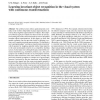Free Online Productivity Tools
i2Speak
i2Symbol
i2OCR
iTex2Img
iWeb2Print
iWeb2Shot
i2Type
iPdf2Split
iPdf2Merge
i2Bopomofo
i2Arabic
i2Style
i2Image
i2PDF
iLatex2Rtf
Sci2ools
BC
2006
2006
Learning invariant object recognition in the visual system with continuous transformations
Abstract The cerebral cortex utilizes spatiotemporal continuity in the world to help build invariant representations. In vision, these might be representations of objects. The temporal continuity typical of objects has been used in an associativelearningrulewithashort-termmemorytracetohelpbuild invariant object representations. In this paper, we show that spatial continuity can also provide a basis for helping a system to self-organize invariant representations. We introduce a new learning paradigm "continuous transformation learning" which operates by mapping spatially similar input patterns to the same postsynaptic neurons in a competitive learning system. As the inputs move through the space of possible continuous transforms (e.g. translation, rotation, etc.), the active synapses are modified onto the set of postsynaptic neurons. Because other transforms of the same stimulus overlap with previously learned exemplars, a common set of postsynaptic neurons is activated by the...
| Added | 10 Dec 2010 |
| Updated | 10 Dec 2010 |
| Type | Journal |
| Year | 2006 |
| Where | BC |
| Authors | Simon M. Stringer, G. Perry, Edmund T. Rolls, J. H. Proske |
Comments (0)

